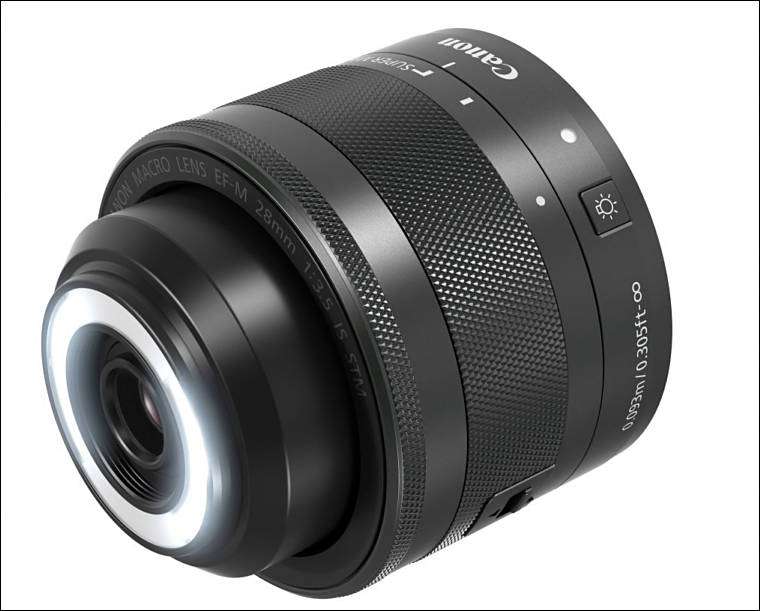
-

- Create superb macro shots with unique in-built Macro Lite
- Get closer to bring out new levels of detail
- Pin sharp images with Hybrid IS and unique design
- Compact stylish design that’s an ideal match for the EOS M
- Easily record smooth movies
- $300 at http://www.amazon.com/Canon-EF-M-28mm-Macro-STM/dp/B01FFACQYW/
-
PR
Photographers looking for a compact, lightweight macro lens should look no further than the Canon EF-M 28mm f/3.5 Macro IS STM lens, the first Canon Macro Lens specifically designed for the EOS M Camera System.
The new lens features a pair of built-in miniature Macro Lite electronic flash units that illuminate close-up subjects as needed, helping to freeze movement, enhance color accuracy and provide a better sense of depth and dimension. Two curved flash units surround the front element of the lens, with the ability to illuminate both simultaneously, or one at a time. Users are also able to adjust the brightness of the Macro Lites between “bright” and “dim” settings.
The standard focusing range of the Canon EF-M 28mm f/3.5 Macro IS STM lens extends from infinity to life-size (1 time). Additionally, a Super Macro Mode allows shooting at even higher magnifications up to 1.2 times. This feature allows you to capture smaller details that really make your subjects stand out against the background.
Additional features of the Canon EF-M 28mm f/3.5 Macro IS STM lens include:
- Hybrid IS, the same feature as found on Canon EF 100mm f/2.8L Macro IS USM Lens, helps reduce camera shake for enjoyable handheld photography.
- Stepping motor (lead screw-type STM) helps provide smooth and quiet focusing operation when taking photos, and near-silence when shooting videos.
- One UD lens and two aspherical lenses** help deliver outstanding image quality at all distance settings by reducing chromatic and spherical aberrations.
- Angle of view similar to a 45mm standard lens (35mm equivalent) provides flexible image capture of various subjects and scenes at macro distances and beyond.
- Tapered lens top shape makes it easy to capture high-quality images at close range without casting shadows.
Canon’s EF-M 28mm f/3.5 Macro IS STM lens is scheduled to be available through authorized Canon dealers in June for an estimated retail price of $299.99.
-

 img920.jpg800 x 630 - 46K
img920.jpg800 x 630 - 46K -

 img940.jpg800 x 613 - 65K
img940.jpg800 x 613 - 65K -

 img1212.jpg800 x 518 - 51K
img1212.jpg800 x 518 - 51K -

 img1245.jpg800 x 520 - 46K
img1245.jpg800 x 520 - 46K -

Center sharpness remains high through from f/3.5 to f/11, with f/16 and f/22 being adversely affected by diffraction. The edges aren't nearly as sharp as the center, with f/5.6 to f/11 producing the sharpest results.
http://www.photographyblog.com/reviews/canon_efm_28mm_f_3_5_macro_is_stm_review/

 img1253.jpg800 x 524 - 73K
img1253.jpg800 x 524 - 73K -

 img2581.jpg800 x 498 - 80K
img2581.jpg800 x 498 - 80K
Howdy, Stranger!
It looks like you're new here. If you want to get involved, click one of these buttons!
Categories
- Topics List23,990
- Blog5,725
- General and News1,353
- Hacks and Patches1,153
- ↳ Top Settings33
- ↳ Beginners256
- ↳ Archives402
- ↳ Hacks News and Development56
- Cameras2,367
- ↳ Panasonic995
- ↳ Canon118
- ↳ Sony156
- ↳ Nikon96
- ↳ Pentax and Samsung70
- ↳ Olympus and Fujifilm101
- ↳ Compacts and Camcorders300
- ↳ Smartphones for video97
- ↳ Pro Video Cameras191
- ↳ BlackMagic and other raw cameras116
- Skill1,960
- ↳ Business and distribution66
- ↳ Preparation, scripts and legal38
- ↳ Art149
- ↳ Import, Convert, Exporting291
- ↳ Editors191
- ↳ Effects and stunts115
- ↳ Color grading197
- ↳ Sound and Music280
- ↳ Lighting96
- ↳ Software and storage tips266
- Gear5,420
- ↳ Filters, Adapters, Matte boxes344
- ↳ Lenses1,582
- ↳ Follow focus and gears93
- ↳ Sound499
- ↳ Lighting gear314
- ↳ Camera movement230
- ↳ Gimbals and copters302
- ↳ Rigs and related stuff273
- ↳ Power solutions83
- ↳ Monitors and viewfinders340
- ↳ Tripods and fluid heads139
- ↳ Storage286
- ↳ Computers and studio gear560
- ↳ VR and 3D248
- Showcase1,859
- Marketplace2,834
- Offtopic1,319











